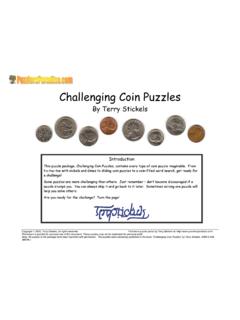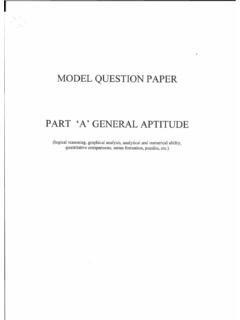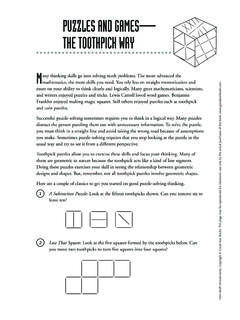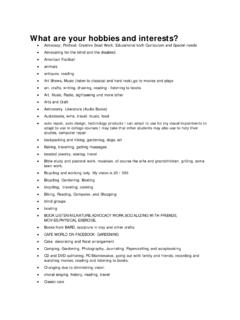Transcription of HOME-BASED COGNITIVE REMEDIATION PROGRAM
1 Welcome! The UAB home Stimulation PROGRAM provides activities for you to use with individuals following their brain injury. These activities are designed to assist the individual in the recovery of their thinking skill. Each activity provides a group of tasks listed by their level of difficulty. The tasks range from the least challenging, Level 1 to higher levels that are progressively more challenging. Select activities that you feel might be appropriate and follow the directions, increasing the level of difficulty as the progress warrants. Work on several tasks each day and shift tasks after a few days to provide variety. These tasks are not meant to substitute for professional therapy and use of the tasks does not guarantee recovery. The tasks are offered to provide some guidance and structure to people with brain disorders and their families.
2 You may print any part of it for use at home . The entire PROGRAM is also found on the Internet at You may not publish any part of this work and any mention of the PROGRAM must include a reference to where it was obtained. We request that you notify us of your use of the PROGRAM and if you find the information useful. The only way we will know if the PROGRAM has met our expectations is if people contact us. We appreciate it! The PROGRAM is set up so you can easily access the tasks. The Activities Table of Contents lists all 48 activities. After the Table of Contents is the Skills Index, which provides a listing of activities that focus on particular thinking skills. The areas include Fine Motor Control, Attention/Concentration Skills, Memory-Orientation Skills, Reasoning/Problem Solving Skills, Visual Spatial Skills, and Language Skills.
3 Be sure to also look at the Appendices, particularly Appendix A (a listing of published materials) and Appendix I (a listing of popular games that can be used for COGNITIVE stimulation). We would like to express our appreciation to the people who have helped us develop and field test this PROGRAM . Augusta Cash, Director of TBI Services for the Alabama Department of Rehabilitation Services has been very supportive. The TBI Care Coordinators of Alabama (Nadine Dunn, Karen Wisenbaker, Leigh Ann Walker, Carol Pinkard, Ron Haynes, Rena Kiel, and Jan Humphries) have used these activities with clients and provided valuable suggestions. Thanks! Tom Novack, PhD and Jacqueline Blankenship, MCD, CCC-SLP. 2002. For further information contact: Research Services, Dept of Physical Medicine and Rehabilitation, University of Alabama at Birmingham, 619 19th St.
4 S SRC 529, Birmingham, AL 35249-7330. 205-934-3283. This document was developed by the UAB Traumatic Brain Injury Model System , which is supported by grant #H133A980010 from the National Institute of Disability and Rehabilitation Research, Office of Special Education and Rehabilitative Services, Dept of Education, Washington, DC. 1. HOME-BASED COGNITIVE STIMULATION PROGRAM . Activities Table of Contents 1. WORKING WITH MONEY .. 10. 2. PLAYING CARDS .. 11. 3. DAILY ACTIVITIES .. 11. 4. SEQUENCING ACTIVITIES .. 12. 5. PUZZLES .. 13. 6. WORKING WITH CLAY.. 14. 7. FINGER TAPPING .. 14. 8. TOSSING BEAN 15. 9. NUTS AND 15. 10. SPATIAL/WRITING SKILLS .. 16. 11. SEARCH AND FIND .. 17. 12. DRIVING SIMULATION .. 18. 13. RECALL OF PICTURES AND 18. 14. PHYSICAL EXERCISE .. 19. 15. SHELL 20. 16. VISUAL SCANNING/CANCELLATION TASKS.
5 20. 17. NUMBER SEQUENCES .. 21. 18. AUDITORY 21. 19. LOCATING INFORMATION .. 22. 20. CODING .. 23. 21. AMERICAN GUIDANCE SERVICE, INC. 24. 22. GED OR COMMUNITY 24. 2. 23. VOLUNTEER WORK .. 24. 24. RECALL OF STORY MATERIAL .. 24. 25. ORIENTATION 25. 26. CLOCK 27. 27. CROSSWORD PUZZLES .. 28. 28. LANGUAGE 28. 29. CATEGORIZATION EXERCISES .. 30. 30. ORGANIZATIONAL ACTIVITIES .. 31. 31. MAP 32. 32. RIGHT-LEFT 33. 33. MAZES .. 34. 34. SOLITAIRE .. 34. 35. WORD SEARCH .. 34. 36. WRITTEN LANGUAGE OR WRITTEN EXPRESSION .. 35. 37. READING COMPREHENSION .. 35. 38. FOLLOWING 36. 39. FILL IN THE BLANK .. 36. 40. HANG MAN .. 36. 41. DEDUCTIVE REASONING .. 37. 42. FINE MOTOR CONTROL .. 38. 43. MATHEMATICAL 38. 44. TIME SENSE .. 39. 45. SPATIAL CENTERING .. 39. 46. TWO DIMENSIONAL ARRAYS .. 39. 47. DRAWING 40. 3. 48. RHYTHM MATCHING.
6 41. APPENDIX A .. 42. APPENDIX B .. 43. APPENDIX C .. 47. APPENDIX D .. 48. APPENDIX E .. 49. APPENDIX F .. 50. APPENDIX 52. APPENDIX H - GAME 53. 4. HOME-BASED COGNITIVE Stimulation PROGRAM Skills Index Fine-Motor Control 1 Levels 1 and 2. 2 Levels 1 through 3. 3 All Levels 5 All Levels 6 All Levels 7 All Levels 8 All Levels 9 All Levels 10 All Levels 11 All Levels 12 All Levels 25 All Levels 34 All Levels 35 All Levels 36 All Levels 38 All Levels 43 All Levels 44 All Levels 5. Attention/Concentration 2 All Levels 23 All Levels 3 All Levels 24 All Levels 4 All Levels 25 All Levels 5 All Levels 26 All Levels 6 All Levels 27 All Levels 7 All Levels 28 All Levels 8 All Levels 29 All Levels 9 All Levels 30 All Levels 10 All Levels 31 All Levels 11 All Levels 34 All Levels 12 All Levels 35 All Levels 13 All Levels 36 All Levels 14 All Levels 37 All Levels 15 All Levels 39 All Levels 16 All Levels 40 All Levels 17 All Levels 41 All Levels 18 All Levels 42 All Levels 19 All Levels 43 All Levels 21 All Levels 44 All Levels 22 All Levels 45 All Levels 6.
7 Memory-Orientation 3 All Levels 24 All Levels 4 All Levels 25 All Levels 5 All Levels 26 All Levels 7 All Levels 27 All Levels 11 All Levels 28 All Levels 12 All Levels 29 All Levels 13 All Levels 30 All Levels 14 All Levels 32 All Levels 16 All Levels 34 All Levels 18 All Levels 39 All Levels 19 All Levels 40 All Levels 21 All Levels 43 All Levels 22 All Levels 44 All Levels Reasoning/Problem Solving 1 Levels 3 through 7 18 All Levels 2 Levels 3 through 9 21 All Levels 3 All Levels 22 All Levels 8 Levels 2 through 5 23 All Levels 12 All Levels 24 All Levels 14 All Levels 25 All Levels 16 All Levels 26 All Levels 7. 27 All Levels 36 All Levels 30 All Levels 43 All Levels 32 All Levels 44 All Levels 34 All Levels 45 All Levels 35 All Levels Visual Spatial Skills 2 All Levels 27 All Levels 4 All Levels 28 All Levels 5 All Levels 29 All Levels 6 All Levels 30 All Levels 7 All Levels 33 All Levels 8 All Levels 34 All Levels 9 All Levels 35 All Levels 10 All Levels 36 All Levels 12 All Levels 37 All Levels 13 All Levels 39 All Levels 16 All Levels 43 All Levels 17 All Levels 44 All Levels 21 All Levels 22 All Levels 8.
8 Language Skills 1 Levels 7 through 9. 14 All Levels 19 All Levels 21 All Levels 23 All Levels 24 All Levels 25 All Levels 26 All Levels 27 All Levels 28 All Levels 30 All Levels 31 All Levels 32 All Levels 34 All Levels 37 All Levels 38 All Levels 39 All Levels 40 All Levels 41 All Levels 42 All Levels 9. HOME-BASED COGNITIVE STIMULATION PROGRAM . Tasks List 1. Working with money LEVEL 1 - Lay 5 to 10 coins on a table (increase the number of coins as attention improves). Ask the student to identify or sort out all quarters, nickels, pennies dimes, etc. and put them in bowls or saucers. Have the student stack coins. Ask the student to alternate, upon command, picking up different sized coins, for example: Pick up a quarter , pick up a penny , now, pick up a dime . LEVEL 2 -- Have the student puts coins into his or her pocket or a small sack and ask the student to reach inside and pull out a quarter or a dime just by feeling it with the fingers.
9 Ask for each denomination of coin. LEVEL 3 -- Engage in making change. Ask the student to tell you which coins would make up 35 cents, 54 cents, etc. Give the student some coins and ask him or her to add the coins and give a total. LEVEL 4 - Increase the amount of money handled by using both coins and paper bills. Have the student determine how much change should be given if something were being purchased (for example, If you bought something that costs $ and paid for it with a $10 bill, how much change should you get back?). If the student has difficulty doing the math mentally, provide coins and bills and perform transactions to demonstrate. LEVEL 5 -- Increase the amounts of money for financial transactions in making purchases. Create false bank account balances and have the student figure new balances considering both credits (additions) and debits (subtractions).
10 LEVEL 6 -- Have the student practice creating a monthly budget, including reasonable amounts for food, rent, utilities, clothing, savings, and transportation. LEVEL 7 -- Brief, planned trips to the store can be a very good exercise for the student. A) To work on reasoning, plan the trip and make a list of things to get at the store. Ask the student to generate the shopping list with some assistance and write down estimated prices for the items, which can then be checked against the actual price. At this level of recovery, the list should be short (4-6 items) and the trip should be brief (no more than 30 minutes in the store, especially the first couple of times). A trip to the grocery store is often a good choice. B) As progress is evident, add more items to the list allowing for more time and more flexibility. This is a good time to challenge the student by engaging in everyday financial transactions!






